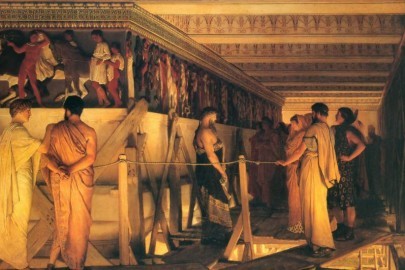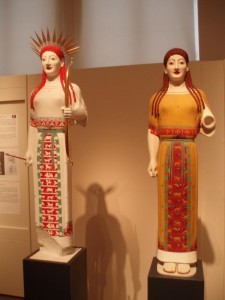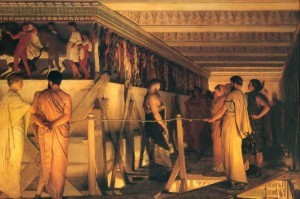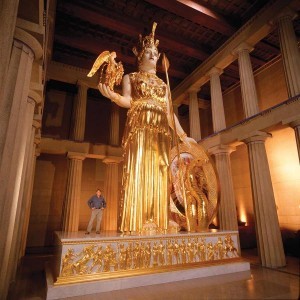For 15 years now, the traveling exhibition Gods in Colour, has been constantly moving from one city of the world to another, challenging the long-established idea that ancient art is a celebration of ‘pure marble white’.
(The Peplos Kore of the Acropolis museum, recreated in vibrant colour as Athena and Artemis)
The exhibition is the love child of the German archaeologist Vinzens Brinkmann, who has been researching ancient polychromy since the early 1980s. Brinkmann, along with other archaologists, have been using ultra-violet light to trace colour on marble statues which retain no signs of their original decorations. The technique has managed to confirm what had been suspected for at least a couple of centuries, since pioneering Hellenist, historian and archaeologist Johann Joachim Winckelmann published his two-volume history of ancient art in 1764: that ancient art would have been a riot of colour and glitzy decoration.
Last week, BBC revisited the issue, after the end of yet another successful run of Gods in Color, this time in San Francisco (it has previously been, among other cities, in Mexico City, Oxford, Vienna, Stockholm, Berlin, Madrid, Amsterdam, Istanbul, Rome and of course, Athens, at the National Archaeological Museum).
Written by Natalie Haynes, the BBC story focuses on a 1868 painting by Lawrence Alma – Tadema, titled ‘Phidias Showing the Frieze of the Parthenon to his Friends’. It depicts the sculptor, one of the most significant artists of the classical era, presenting his work on what is now considered one of the most important monuments in the world. What caused a stir at the time was that the painter chose to present the sculptures in vibrant colours, something that was considered a kind of sacrilege.
Phidias also created a huge statue of Athena Parthenos to stand inside the Parthenon, which has acquired legendary status since its destruction, though a modern day replica in Nashvill, by Alan LeQuire is acknowledged as the larger indoors statue in the world. It is covered in gold and ivory, as the original was, evidence of the multicolor nature of Ancient art. Other evidence comes from roman murals, depicting painted statues.
Despite all evidence and historical analysis, the idea of colored statues still unsettling for an audience long educated to consider classical Greek art as a sea of white serenity. But, as Natalie Haynes writes, “the global audience for Brinkmann’s Gods in Colour exhibition has surely proved that there is an appetite for modern recreations of the brightness of ancient statuary.”
Source: neoskosmos.com
Ask me anything
Explore related questions








